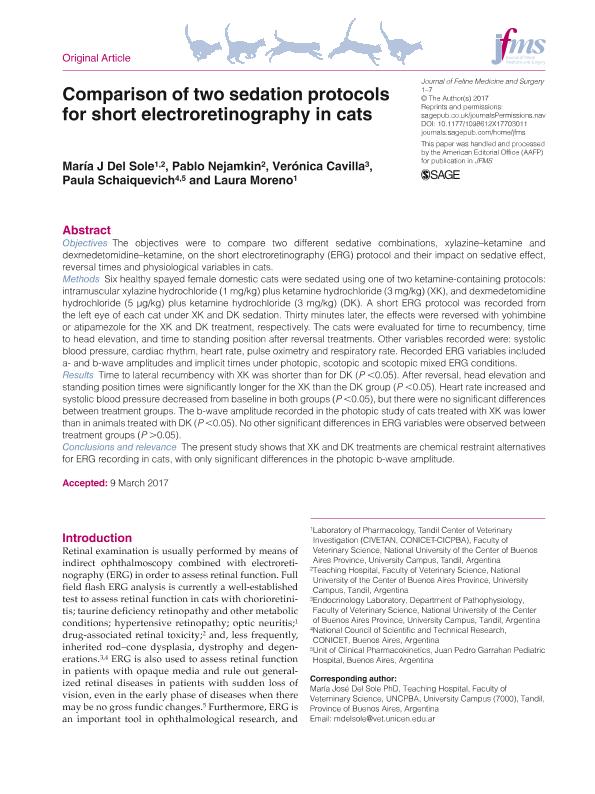Mostrar el registro sencillo del ítem
dc.contributor.author
del Sole, Maria Jose

dc.contributor.author
Nejamkin, Pablo

dc.contributor.author
Cavilla, María Verónica

dc.contributor.author
Schaiquevich, Paula Susana

dc.contributor.author
Moreno, Laura Susana

dc.date.available
2018-09-06T20:08:01Z
dc.date.issued
2018-02
dc.identifier.citation
del Sole, Maria Jose; Nejamkin, Pablo; Cavilla, María Verónica; Schaiquevich, Paula Susana; Moreno, Laura Susana; Comparison of two sedation protocols for short electroretinography in cats; Elsevier; Journal Of Feline Medicine And Surgery; 20; 2; 2-2018; 172-178
dc.identifier.issn
1098-612X
dc.identifier.uri
http://hdl.handle.net/11336/58617
dc.description.abstract
Objectives: The objectives were to compare two different sedative combinations, xylazine–ketamine and dexmedetomidine–ketamine, for the short electroretinography (ERG) protocol and their impact on sedative effect, reversal times and physiological variables in cats. Methods: Six healthy spayed female domestic cats were sedated using one of two ketamine-containing protocols: intramuscular xylazine hydrochloride (1 mg/kg) plus ketamine hydrochloride (3 mg/kg) (XK), and dexmedetomidine hydrochloride (5 µg/kg) plus ketamine hydrochloride (3 mg/kg) (DK). A short ERG protocol was recorded from the left eye of each cat under XK and DK sedation. Thirty minutes later, the effects were reversed with yohimbine or atipamezole for the XK and DK treatment, respectively. The cats were evaluated for time to recumbency, time to head elevation, and time to standing position after reversal treatments. Other variables recorded were: systolic blood pressure, cardiac rhythm, heart rate, pulse oximetry and respiratory rate. Recorded ERG variables included a- and b-wave amplitudes and implicit times under photopic, scotopic and scotopic mixed ERG conditions. Results: Time to lateral recumbency with XK was shorter than for DK (P <0.05). After reversal, head elevation and standing position times were significantly longer for the XK than the DK group (P <0.05). Heart rate increased and systolic blood pressure decreased from baseline in both groups (P <0.05), but there were no significant differences between treatment groups. The b-wave amplitude recorded in the photopic study of cats treated with XK was lower than in animals treated with DK (P <0.05). No other significant differences in ERG variables were observed between treatment groups (P >0.05). Conclusions and relevance: The present study shows that XK and DK treatments are chemical restraint alternatives for ERG recording in cats, with significant differences only in the photopic b-wave amplitude.
dc.format
application/pdf
dc.language.iso
eng
dc.publisher
Elsevier

dc.rights
info:eu-repo/semantics/openAccess
dc.rights.uri
https://creativecommons.org/licenses/by-nc-sa/2.5/ar/
dc.subject
Feline
dc.subject
Sedative
dc.subject
Erg
dc.subject.classification
Ciencias Veterinarias

dc.subject.classification
Ciencias Veterinarias

dc.subject.classification
CIENCIAS AGRÍCOLAS

dc.title
Comparison of two sedation protocols for short electroretinography in cats
dc.type
info:eu-repo/semantics/article
dc.type
info:ar-repo/semantics/artículo
dc.type
info:eu-repo/semantics/publishedVersion
dc.date.updated
2018-09-05T16:11:32Z
dc.identifier.eissn
1532-2750
dc.journal.volume
20
dc.journal.number
2
dc.journal.pagination
172-178
dc.journal.pais
Países Bajos

dc.journal.ciudad
Amsterdam
dc.description.fil
Fil: del Sole, Maria Jose. Consejo Nacional de Investigaciones Científicas y Técnicas. Centro Científico Tecnológico Conicet - Tandil. Centro de Investigación Veterinaria de Tandil. Universidad Nacional del Centro de la Provincia de Buenos Aires. Centro de Investigación Veterinaria de Tandil. Provincia de Buenos Aires. Gobernación. Comision de Investigaciones Científicas. Centro de Investigación Veterinaria de Tandil; Argentina
dc.description.fil
Fil: Nejamkin, Pablo. Consejo Nacional de Investigaciones Científicas y Técnicas; Argentina. Universidad Nacional del Centro de la Provincia de Buenos Aires. Facultad de Ciencias Veterinarias; Argentina
dc.description.fil
Fil: Cavilla, María Verónica. Consejo Nacional de Investigaciones Científicas y Técnicas; Argentina. Universidad Nacional del Centro de la Provincia de Buenos Aires. Facultad de Ciencias Veterinarias. Departamento de Fisiopatología. Laboratorio de Endocrinología; Argentina
dc.description.fil
Fil: Schaiquevich, Paula Susana. Consejo Nacional de Investigaciones Científicas y Técnicas. Centro Científico Tecnológico Conicet - Tandil. Centro de Investigación Veterinaria de Tandil. Universidad Nacional del Centro de la Provincia de Buenos Aires. Centro de Investigación Veterinaria de Tandil. Provincia de Buenos Aires. Gobernación. Comision de Investigaciones Científicas. Centro de Investigación Veterinaria de Tandil; Argentina. Gobierno de la Ciudad de Buenos Aires. Hospital de Pediatría ; Argentina
dc.description.fil
Fil: Moreno, Laura Susana. Consejo Nacional de Investigaciones Científicas y Técnicas. Centro Científico Tecnológico Conicet - Tandil. Centro de Investigación Veterinaria de Tandil. Universidad Nacional del Centro de la Provincia de Buenos Aires. Centro de Investigación Veterinaria de Tandil. Provincia de Buenos Aires. Gobernación. Comision de Investigaciones Científicas. Centro de Investigación Veterinaria de Tandil; Argentina
dc.journal.title
Journal Of Feline Medicine And Surgery

dc.relation.alternativeid
info:eu-repo/semantics/altIdentifier/url/http://journals.sagepub.com/doi/10.1177/1098612X17703011
dc.relation.alternativeid
info:eu-repo/semantics/altIdentifier/doi/https://doi.org/10.1177/1098612X17703011
Archivos asociados
